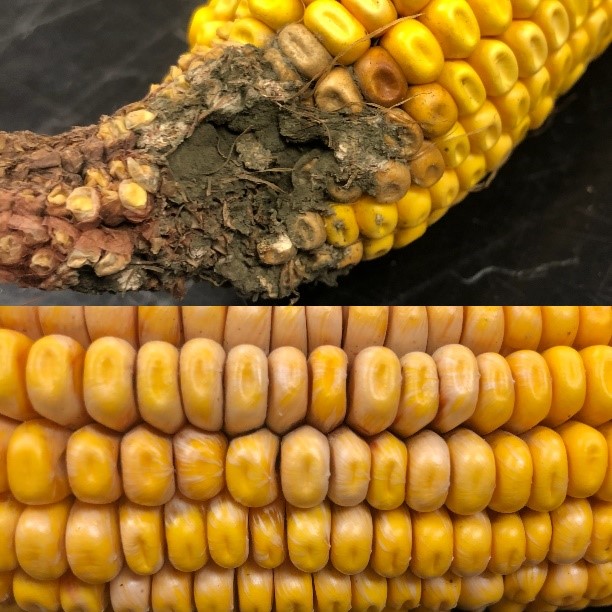Fall strategies to reduce impact of mycotoxins in corn grain
Scout corn now for potential ear rot and mycotoxin issues due to recent wet and cool weather conditions.

With corn grain harvest quickly approaching in Michigan, consider your risk of mycotoxins this year. With a wetter than normal August and September through much of Michigan, risk of mycotoxins may be high in corn this year. While prevention of mycotoxins through pre-harvest management is the best approach in reducing mycotoxin accumulation, now is the time to implement post-harvest management strategies to reduce issues at the grain elevator.
If you haven’t already, now is the time to do a late season scouting of fields to determine the amount of fungal growth and potential mycotoxins already in the field. Scouting should consist of five random spots in the field and pulling the husks off of 20 ears on consecutive plants at each location, totaling 100 ears per field. Scouting will give you a sense of which fields have high potential for mycotoxins through increased fungal activity in current weather.
Fields with higher potential for mycotoxins should be treated differently than fields with a lower potential. In general, fields that are earlier harvested will have a lower concentration of mycotoxins as fungal pathogens will have less time to develop in the ear and potentially produce mycotoxins. Also, continued damage from insects and other pests later in the season can lead to the accumulation of mycotoxins as damaged kernels allow for easier infection. Because mycotoxins can continue to accumulate during dry down, consider harvesting higher risk fields first. If there are little to no signs of fungal infections and pest damage is not a problem, allowing field drying under favorable conditions should be a safe option.
Another option to reduce mycotoxins in storage is to make adjustments to combine settings to reduce both damaged kernels and the number of kernels with fungal infections making it into storage. Physical damage to the kernels during harvest increases potential for fungal infection and for mycotoxins to develop. Adjusting the combine’s cylinder speed and clearance can reduce damage to kernels by reducing their physical contact with moving combine parts.
Also, adjustments can be made to discard moldy kernels. Increasing the fan speed so that lower density kernels are discarded can reduce the amount of mycotoxins in stored grain. Kernels infected with ear rot fungi are often lower density and therefore lighter and will be blown out. Because increasing discarded grain will decrease yield, balance this with the need to discard infected grain.

After harvesting, drying grain is important in stopping the development of fungal pathogens. Grain from fields that have ear molds should be dried as quickly as possible at a high temperature to stop the development of mycotoxins. Studies have shown that increasing the amount of time between harvesting and drying increases the amount of mycotoxins found in the grain. Corn grain should be dried to at least 14 percent moisture content for storage. At this temperature, fungal microbes respire slowly which inhibits grown. Respiration increases above 14 percent moisture, which can result in an increase in temperature and sometimes spontaneous heating of stored grain.
While in storage, minimize the amount of fungal pathogens that are able to grow in storage. Prior to storing grain, clean out the grain bin to remove inoculum that may be present from the previous season. Problems while in storage are often due to moisture variability within the structure or moisture that develops inside the bin. Proper aeration can be used to control moisture in storage by reducing condensation.
Storage temperature is also critical in managing mycotoxins in stored grain. Grain should ideally be cooled to between 33.8 and 39.2 degrees Fahrenheit because fungal development is reduced at this temperature. In the summer, keep grain between 50 and 59 F. Aeration is essential to help control temperature in grain bins and should be done when the temperatures are cool to help cool the bin.
Lastly, regular observations of the grain bin are important to determine if mycotoxin problems may be arising in storage. Check grain bins weekly during the warm months and every other week during cooler months. When checking the grain bin temperature, monitor moisture and visual symptoms of fungal infection.
Overall, steps can be taken now to help reduce the impact of mycotoxins in corn grain this season. Though strategies can be implemented now, it is important to know that a whole season management program is the best defense against mycotoxins. If problems arise this year, give thought to a management strategy for future years. Pre-harvest techniques such as hybrid selection, fungicide application, managing surface residue etc. should be discussed now to be prepared for mycotoxin issues in the future.
This research is funded in part by Corn Marketing Program of Michigan and Michigan State University AgBioResearch.
Please email any observations on ear molds and mycotoxins to blaineka@msu.edu or msingh@msu.edu.



 Print
Print Email
Email